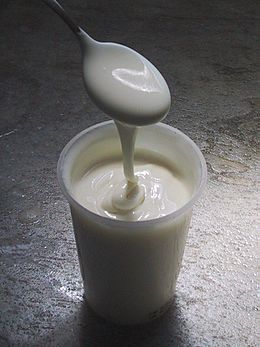Requeijão facts for kids
Quick facts for kids Requeijão |
|
|---|---|
 |
|
| Country of origin | Portugal and Brazil |
| Source of milk | Cow, goat and sheep |
| Pasteurized | Depends on variety |
| Texture | solid to creamy |
| Aging time | Depends on variety |
| Certification | No |
Requeijão is a creamy dairy product from Portugal and Brazil. It's a bit like a soft, spreadable cheese. People often use it to make delicious cheese spreads.
Sometimes, you might find this type of cheese wrapped in fresh corn husks. In El Salvador, a similar cheese called requesón is sometimes carried in banana leaves.
In Portugal, requeijão is usually white or yellowish-white and solid. It has a strong, unique taste. You'll often see it sold in special plastic containers or woven baskets.
Brazilian requeijão is a type of cream cheese, but it's not quite like the cream cheese you might know from America. Think of it more as a "cheese cream." It has a mild taste and can be very creamy, like condensed milk, or even a bit more liquid.
This creamy cheese first became popular in the state of Minas Gerais in Brazil. Over time, it spread to other big cities like Rio de Janeiro and São Paulo. Now, you can find it all over Brazil. The most common type is requeijão cremoso. It's often sold in glass or plastic cups, which many Brazilians reuse as drinking glasses!
You might also find requeijão in a popular Brazilian dessert called Romeu-e-Julieta. This dessert mixes white cheese with guava paste. Requeijão is also a favorite topping for Brazilian pizzas, crêpes, waffles, and even spring rolls.
How Requeijão is Made
Making requeijão starts with skim milk. The milk is left until special lactic acid bacteria make its proteins curdle. This means the milk thickens and forms soft lumps.
Next, the curdled milk is stirred and heated to about 80 degrees Celsius (175 degrees Fahrenheit). Then, the liquid part, called whey, is drained away. The soft curd is collected in bags and pressed.
The pressed curd is then broken up and washed with warm skim milk. This creates a new mixture. This mixture is stirred and heated again. The casein (a protein in milk) in the new milk sticks to the curd.
This process of draining, pressing, adding more skim milk, and heating is repeated one more time. After that, the curd is drained again. Salt is added, about 2 to 2.5% of the curd's weight. The mixture is then kneaded on a table for about 15 minutes.
Finally, hot milkfat or dairy cream is added. About one part of butterfat is added for every five parts of curd. This mixture is heated and stirred one last time. The cheese is then shaped in special boxes lined with parchment paper.
From 100 kilograms of skim milk and 3.4 kilograms of cream, about 11 kilograms of requeijão cheese can be made. This cheese usually has 55-70% water, 8-20% fat, and 16-20.5% protein.
Special Requeijão from Serra da Estrela
There's a special type of requeijão made in the Serra da Estrela region of Portugal. It's called Requeijão da Serra da Estrela. Since 2005, this cheese has a special status called Protected Designation of Origin (PDO/DOP) in the EU and the UK. This means only requeijão made in this specific region, following certain rules, can use this name.
See also
 In Spanish: Requeijão para niños
In Spanish: Requeijão para niños

